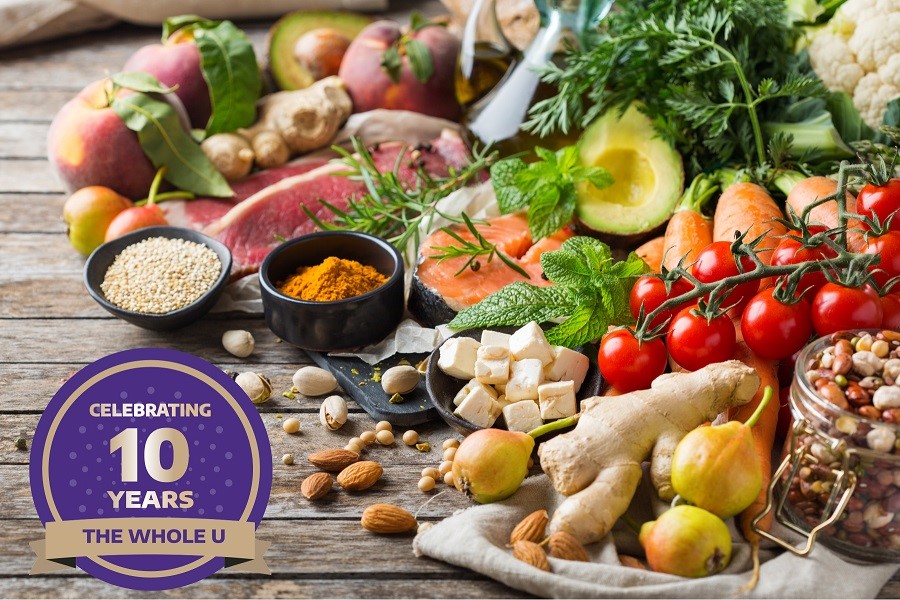
Trending positive: top 10 ways to properly fuel your body
Nutrition trends can have a major influence on us as we navigate our overall health and performance. We are eager to try the latest nutrition trend that shows up on our social media feeds or the newest supplement or diet that claims to be life changing.

Judy Simon
When I asked Judy Simon, one of our UWMC dietitians, about fad diets and trendy supplements, she had three common observations: 1. they are not sustainable in the long term, 2. they can be very expensive and 3. they often lack the varied nutrients our bodies need.
But Simon is seeing at least one positive nutritional trend: a tendency toward eating more plant-based or plant-forward meals—for both health and sustainability.
“You don’t have to be strictly vegetarian to gain the benefits of a plant-forward diet,” she says. “More fiber improves gut health. Optimizing gut health not only helps people feel better now, it also contributes to preventing and managing many chronic diseases. It’s exciting to see a trend towards more fruits, vegetables and whole grains.”
Simon advises making small changes that will have a big cumulative impact on your overall health over time. Being more mindful here and there about the food we eat can set the groundwork for other sustainable wellness goals while helping us feel energized and ready to take on the day.
She adds that the secret to a healthy, balanced diet is really no secret at all. It is simply understanding your body’s needs and finding what works for you. Here, Simon shares her top 10 tips to make a habit of healthy, mindful eating.
1. Get excited about nutrition
Healthy foods are often assumed to be boring and flavorless. With this assumption, it can be hard to be inspired to eat healthy. “Healthy eating is not about being on your best behavior,” Simon says. “It’s about finding delicious alternatives that you will crave. Nutrition is always an easier sell if you link it to food and how wonderfully tasty it can be and how good it makes us feel.”
2. Eat more plant-based foods
Plant-based foods are perfect for providing energy. Simon champions certain carbohydrates for providing energy, such as grains, whole wheat, quinoa and beans. Additionally, fruits, vegetables, seeds and nuts are going to provide energy as well. It is important to note that energy needs will differ depending on the person.
3. Know the difference between hunger and thirst
Water is great for helping with digestion, slowing down fast eaters and providing our bodies with energy. Unfortunately, Simon cautions us that, “a lot of times people mix up their signals for whether they’re hungry or thirsty. If this is true, eating food typically isn’t going to satiate that hunger.”
The real trick to knowing whether you’re hungry or thirsty is reading your body. Take a second and ask yourself when is the last time you drank a cup of water? With a meal, Simon recommends having at least 8-12 ounces of some type of fluid—ideally water-based—then continue to sip throughout the day.
4. Keep a meal log
“For someone who is curious about how they’re doing, eating logs are a really good starting point,” Simon explains. “When you start to enter things in, you become more aware of your habits and notice eating trends you otherwise wouldn’t.”
For example, a lot of us overestimate how many fruits and vegetables we really eat, until we look at our typical day. Phone apps can be helpful for this, but it is important how we interpret the information they give us. Sometimes eating logs can do more harm than good if we are too hard on ourselves. It’s all about finding balance.
5. It’s all about greens and beans
Not sure what exactly to eat? Go for the greens and beans! Greens and beans such as lentils, legumes, and beans, are a great source of protein and fiber. Thirty percent of a bean or lentil is protein! Soy, edamame, and lentils are also more affordable sources of protein if you’re looking to eat healthy on a budget.
“Beans have iron, fiber, magnesium, and so many other good nutrients! Greens as well have great amounts of folic acid, iron, potassium, and Vitamin K. Greens and beans are perfect for whipping up a variety of meals with many different combination options!”
6. Incorporate healthy fats
Healthy fats are a great addition to every meal because we need the fat to absorb some of the vitamins from our greens and beans. “Adding in a little fat like a small bit of olive oil, seeds, nuts or avocado is a great source of fat and energy,” Simon says. “Obviously, we don’t want too much, but it’s a great source of energy!”
7. Front-load your energy with breakfast
For those of us who have a busy day where we need to be alert and on our toes, front-loading our energy by having a fulfilling breakfast is the perfect way to fuel. If you swear you can’t eat anything before noon, try and see the difference in how you feel. There are so many options for a filling breakfast, whether you eat the minute you wake up, take it on the go, or wait until you’re sitting at your desk.
“It doesn’t have to be a traditional breakfast! It can be leftover dinner for breakfast, a little wrap with veggies, hard-boiled eggs, or a power bowl,” Simon says, cautioning that, “skipping breakfast can be bad if you don’t eat for several hours after waking up. You’re putting your body into starvation mode after a long fast and then it wants to hang onto fat. This makes you want to eat more later.”
8. Read your labels
Food labels not only tell us the nutrients in our food, but also each individual component. Simon recommends comparing the nutrition label with the ingredients and really thinking about what is added and what is from a whole food. For example, sometimes you’ll read a label and it has sugar hidden behind five different ingredients. With sugar, really look to see if the sugar is added versus part of a key ingredient such as fruit.
A common misconception with labels is that frozen foods are all bad. When things are out of season, Simon says it is okay to eat frozen. Most frozen fruits and vegetables are picked at the time of freshness and immediately frozen so they’re not processed. Watch out for the sauces, and don’t forget to look at the label for sneaky additives!
9. Pack and plan ahead
Packing ahead saves time and money. We all have those moments where it’s the afternoon and we’ve already eaten our lunch but need a little something to tide us over so we buy a bag of chips and dig in. This won’t give us energy or help us last until dinner.
Instead, pack ahead stable foods that provide energy and don’t need refrigeration. Whether it’s an energy-packed granola bar or a peanut butter sandwich, these snacks require less effort to maintain, but give us that much needed boost.
10. Know your environment
Sometimes we don’t have a choice where we eat, but when we do, make the decision to not eat distracted. The worst place we can eat a meal is on the couch with the television on. Challenge yourself to clear off a counter and eat with purpose. Focus on how the food tastes and whether it’s meeting your nutrition needs.
“You don’t need a traditional dining room,” Simon says. “Turn off the devices and make eating a fun, sit-down experience. If you’re by yourself, put on some music. Do something that creates a space to focus on your eating. You’ll feel more satisfied and improve your digestion.” With spring just around the corner, it’s even better to get outside if you can!
Healthy living is all integrated. Simon says simply asking ourselves, “what am I doing for self-care?” can go a long way toward helping us recognize our food patterns: “Have confidence and build on the skills that you have when it comes to eating healthy. Don’t feel like you have to be an amazing chef to cook a good meal. Start simple and experiment”
Judy Simon has presented for The Whole U many times over the years. Below is her latest seminar on nutrition for optimal health.
One Thought on “Trending positive: top 10 ways to properly fuel your body”
On January 31, 2024 at 3:45 AM, Camping said:
I wanted to express my appreciation for your insightful advice on nutrition trends and healthy eating habits as featured in the recent article. Your emphasis on the pitfalls of fad diets and the positive trend towards plant-based meals is invaluable information for individuals navigating their health and performance. The ten tips you provided for healthy, mindful eating, including distinguishing hunger from thirst and front-loading energy with breakfast, offer practical guidance for building sustainable habits. Thank you for sharing your expertise and contributing to the promotion of overall well-being.
Comments are closed.